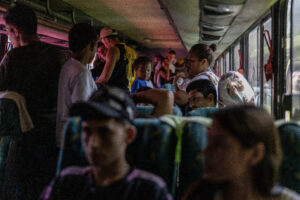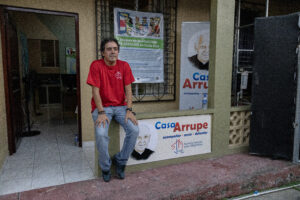- Slug: Costa Rica Migration Policy. 1,725 words.
- Photos available.
By Christopher Lomahquahu
Cronkite Borderlands Project
PASO CANOAS, Costa Rica – Migrant advocates in this small town on the Panama-Costa Rica border say their country has become the United States’ “tercera frontera” – its third border – a place where the U.S. hopes to slow migrants from continuing north.
The Costa Rican government, however, has implemented a busing system that actually speeds migrants northward, while relatively few are able to enroll in a system designed by the U.S. government to stem the flow of people headed to the U.S. border.
In 2023, the U.S. tapped Costa Rica and three other countries – Guatemala, Colombia and Ecuador – for new “Safe Mobility” offices. Migrants can apply for “refugee resettlement” in the United States or elsewhere, without having to travel to the U.S. border to seek asylum. Migrants are also provided information about other legal migration pathways. The program uses an innovative online system for submitting and tracking applications.
During the administration of President Joe Biden, 22 % of asylum applications have been approved, but 77 % of applicants have remained in the United States, whether approved or not. Only a small fraction of applicants end up being deported if their application is denied. Proponents of the Safe Mobility offices say the system could reduce the number of undocumented immigrants in the U.S. and the flow of migrants to the southern border, while keeping more migrants safe from the dangers of traveling through multiple countries.
In Costa Rica, the Safe Mobility program is managed by the U.S. State Department, the United Nations High Commissioner for Refugees (UNHCR) and the International Organization for Migration (IOM).
A September 2024 report from the Mixed Migration Centre said, “despite their flaws, the Offices offer a new path to protection in an environment where such things are rare.”
But one of the program’s major shortcomings, according to the report, is the low number of migrants who attempt to use it. That’s due to low recruitment levels and the limited nature of legal migration pathways to the United States.
“While the SMOs have been successful in resettling thousands of refugees and are generally seen as a positive initiative, the study finds they so far have limited influence on the number of people traveling along dangerous migration routes in the region,” the Mixed Migration Centre said in a press release.
A representative with the U.S. Embassy in Costa Rica said as of this February, the office had facilitated 10,400 claims, a small fraction of the almost half a million migrants and refugees the UNHCR said made their way through Costa Rica in 2023 with the goal of reaching the U.S.
“We have a very close and cooperative relationship with Costa Rica – they’re a strong partner,” said a State Department official at the U.S. embassy in Costa Rica.
But the Safe Mobility program apparently isn’t well-known, even at high levels of the Costa Rican government.
“I haven’t heard of it,” said Stephan Brunner, one of Costa Rica’s two vice presidents, in an interview with the Cronkite Borderlands Project.
In fact, in contrast to the goals of the Safe Mobility program, the Costa Rican government is operating a system that speeds migrants northward.
Brunner said the heavy flow of migrants passing through Costa Rica prompted President Rodrigo Chaves to declare a state of emergency in September 2023.
Weeks later, Costa Rica and Panama agreed upon a plan to quickly bus migrants through the two countries. Panama receives migrants who enter its southern border from Colombia, after crossing the dangerous Darién Gap, and buses them north to Costa Rica, which, in turn, buses the migrants north to Nicaragua.
“What we do is we take them at the southern border, and we charge $30 – they get on a bus, and they will be driven to the northern border to Nicaragua for $30 the same day they come here,” Brunner said. “The numbers fluctuate a lot – we have had 4,000 a day, but we also have had 1,000 a day, it goes up and down.”
Brunner said some migrants are allowed to use the bus system for free, on humanitarian grounds. This is not something the government advertises, however, for fear that every migrant will demand to ride for free.
Historically, Costa Rica’s policies towards immigrants have been welcoming. Nearly 9 percent of the country’s 5.2 million residents are foreign born, two-thirds of whom were born in Nicaragua. The U.S. Embassy said about 150,000 Americans live in the country.
Brunner said migrants who stay in Costa Rica are people who are ill and need medical care or do not have enough money for their travel.
“We have a universal medical service system. So even despite their legal status, whoever is a human being will get medical attention,” Brunner said.
Many migrants don’t have the money for the bus system – or any other type of transportation. They often work odd jobs or solicit donations until they have enough funds to continue their way north. Brunner said no one is formally deported, but the bus system moves hundreds of migrants out of the country each day.
Every morning in Paso Canoas, a small town just across the border from Panama, government chartered buses full of migrants line up waiting for a police escort to Costa Rica’s Temporary Migrant Attention Center, known by its Spanish acronym CATEM.
CATEM is a fenced-off facility operated by the Ministerio De Gobernación Y Policía (Ministry of the Interior and Police), which monitors the flow of migrants in and out of the complex.
This is the first stop on the bus route that takes migrants north to Nicaragua.
Unlike the Safe Mobility offices, the system is designed to move migrants quickly and safely northward, albeit under the watchful eye of the government.
Despite its movement of migrants toward their ultimate goal, advocates like Roy Arias, coordinator for the Jesuit Migrant Service in Paso Canoas, sees CATEM and the bus system as an effort by governments to control and monitor them.
“They call them migration stations, and supposedly, they are humanitarian stations, but there’s a focus on police and military control,” Arias said. “It’s what we call the externalization of the United States border. It’s the pressure from the United States government and the funding for this border to be a point of containment.”
Arias said places like CATEM are detention centers meant to keep migrants in one place, because they are not allowed to leave the facility, except through the buses the government has contracted through a private company, Tracopa.
“This is the third border,” Arias said, explaining that he considers the U.S.-Mexico border to be the “first border;” the Mexico-Guatemala border the “second border;” and the Costa Rica-Panama border the “third border.”
A bus station in Uvita, a seaside destination tourists flock to, is the first stop outside of CATEM, where migrants have an opportunity to stretch and get food, water and other refreshments.
On a day in early March, members from the Congregación de Nuestra Señora de la Caridad del Buen Pastor (Congregation of Our Lady of Charity of the Good Shepherd) were present to hand out meals and water to the migrants.
After an hour in Uvita, the migrants load up on the buses once more for their next stop in the roadside town of Orotina, which is about an hour and a half west of San Jose. In Orotina, migrants transfer to new buses, bound for the border with Nicaragua.
Migrants at the Uvita bus station described their experience going through the Darién Gap, to get to Panama and to keep moving northward.
“I crossed the Darién in two days to get out of the mountain,” said Antonio Jose Martinez, a migrant from Venezuela. He recounted one instance where thieves came along and demanded money from the migrants, searching them all the way down to the soles of their shoes.
“They take your shoes off, they remove the sole to see if you’re carrying money hidden underneath,” Martinez said.
A father of three children, Martinez’s employment situation was dire and his employer eventually stopped paying him. His goal is to reach the U.S. and send money back to his family in Venezuela.
Martinez said the Darién Gap is filled with migrants wading through rivers and harsh terrain, suffering from all types of injuries and illnesses. He witnessed a woman die of a heart attack.
“It’s horrible, it’s not easy at all, I don’t tell anyone to do it. I don’t recommend it to anyone,” Martinez said.
The danger and difficulty that Martinez describes is exactly what the Safe Mobility program is designed to prevent.
However, many migrants see no benefit from the program because they do not qualify for asylum in the U.S. or refugee resettlement.
To use SMO services, migrants must have entered the country before the offices were opened. To qualify for refugee status and resettlement in the U.S., they must prove that they have been or are in danger of being persecuted in their home country or have special need of protection on humanitarian grounds. The U.S. government also establishes yearly limits on the number of refugees admitted. The limit for 2024 is 125,000.
According to the State Department, SMOs have provided refugee resettlement in the United States for 17,600 people since their inception. However, 1,527,537 asylum cases are pending in U.S. immigration courts as of August 2024.
In its report, the Mixed Migration Center said the number of people the SMOs “are serving is much smaller than those seeking immigration opportunities.”
One of those migrants seeking opportunity is Adriana Farfan, who is from Peru.
“It’s really, really exhausting, we’ve been traveling for about a month,” said Farfan, who reached the Uvita bus station with her family.
Farfan said she and her family left Peru because her job gathering oysters along the country’s coastline paid so little and other jobs were not available.
“The work there is very uncertain – one day we were working and then not, but had to pay rent, so it was for economic reasons that we left,” Farfan said.
Because she left Peru for economic reasons, Farfan likely does not qualify for refugee or asylum status. If she wants to get across the U.S. border, she will have to look for other pathways, including illegal immigration. In the meantime, she is continuing on her journey north.
For more stories from Cronkite News, visit cronkitenews.azpbs.org.







